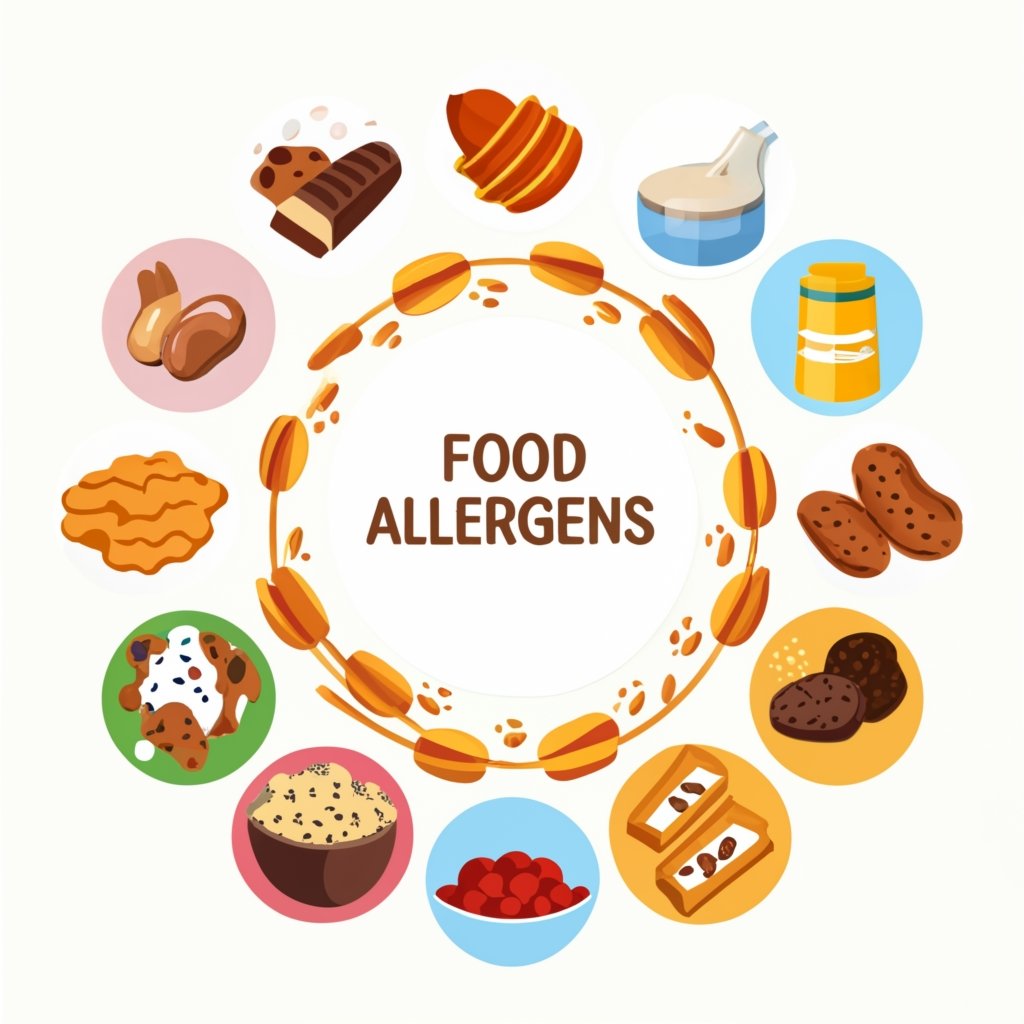Table of Contents
ToggleIntroduction
Food allergies have become a prevalent concern in our modern society.Whether it’s the child who can’t eat peanuts, the lactose-intolerant individual avoiding milk, or the person with an egg allergy carefully reading ingredient labels, food allergies have made their mark on our culinary landscape.
Why is it so important for us to understand what triggers these allergic reactions?
When we talk about food allergies, we are referring to immune system responses that occur when certain foods are consumed.
This immune response leads to a variety of symptoms ranging from mild itching and hives to severe anaphylaxis, which can be life-threatening.
Understanding the prevalence of food allergies is crucial in recognizing just how big of an issue this is.
According to recent studies, it is estimated that around 32 million Americans have some form of food allergy.
That’s roughly 10% of the population! Children are particularly susceptible, with about 1 in every 13 kids having a food allergy.
In the following sections of this article, we will take a closer look at some common food allergens like peanuts, milk, and eggs before diving into lesser-known triggers like pollens, sesame seeds, and shellfish.
Understanding Food Allergies
To understand food allergies, we must explore the active workings of our immune system, which plays a vital role in protecting us from harmful invaders such as bacteria, viruses, and parasites.
Sometimes this protective shield can malfunction and erroneously identify harmless proteins in specific foods as dangerous threats.
This error triggers a robust immune response, leading to the familiar symptoms associated with food allergies.
The immune system initiates its response to a food allergen when specialized cells known as mast cells encounter the allergenic protein.
These mast cells possess tiny chemical grenades called histamines, which they deploy upon encountering an allergen.
Histamines assume responsibility for inducing allergic symptoms, including itching, hives, swelling, and even life-threatening reactions known as anaphylaxis.
Therefore, when an individual with a food allergy consumes their trigger food, such as peanuts, the immune system identifies peanut proteins as hostile intruders and responds by releasing a substantial quantity of histamines throughout the body.
Differentiating Between Food Allergies and Intolerances
The main difference between food allergies and intolerances lies in their underlying mechanisms.
Food allergies, characterized by immune-mediated responses, occur when certain proteins in foods trigger an erroneous immune system reaction.
In these cases, the immune system misidentifies these proteins as threats and launches a defensive attack against them.
This immune response can lead to a spectrum of allergic symptoms, ranging from mild skin rashes or digestive issues to potentially life-threatening reactions.
Food allergies lead to a range of allergic symptoms that can vary in severity, from mild skin rashes or digestive issues to potentially life-threatening reactions.
Now, let’s shift our focus to food intolerances, which stem from difficulties in digesting specific substances found in foods, without involving the immune system.
A common example is lactose intolerance, where individuals lack the enzyme lactase required to break down lactose, the sugar present in milk.
This deficiency results in digestive discomfort, including symptoms like bloating, gas, and diarrhea.
Food allergies demand strict avoidance of allergenic foods, while food intolerances often require thoughtful adjustments, like limiting the intake of specific substances or discovering suitable alternatives to maintain a balanced diet without triggering troublesome symptoms.

Peanuts: The Notorious Food Allergy
Peanuts frequently dominate discussions regarding food allergies because they rank among the most prevalent and severe forms.
Both children and adults can suffer from peanut allergies, and what makes them especially worrisome is their capacity to trigger severe allergic reactions, including anaphylaxis.
Anaphylaxis presents a life-threatening scenario characterized by difficulties in breathing, a sudden drop in blood pressure, and, in some cases, loss of consciousness.
In reality, the majority of fatal food allergy reactions can be attributed to peanut allergies.
Hidden Sources of Peanuts in Everyday Products
Peanut allergies pose a challenge because peanuts can lurk in various unsuspecting products, requiring individuals with this allergy to actively read ingredient labels.
In addition to easily identifiable sources like whole peanuts or peanut butter, hidden ingredients like arachis oil or groundnuts may contain peanuts.
Packaged foods such as cookies, cereals, energy bars, sauces, and even some vegetarian meat substitutes frequently contain peanuts as well.
Another concern is cross-contamination, as products processed on shared equipment with peanuts might carry traces of this allergen.
Milk: More Than Just Lactose Intolerance
Milk allergy is a serious condition that can cause a range of symptoms, including hives, wheezing, and even life-threatening anaphylaxis.
It occurs when the immune system mistakenly identifies milk proteins as harmful invaders and launches an attack.
This immune response can affect various parts of the body, such as the skin, respiratory system, and digestive tract.
Individuals with milk allergy must be vigilant about avoiding all sources of milk proteins, including milk itself, as well as dairy products like cheese, yogurt, and butter.
Reading food labels carefully and communicating food allergies to restaurant staff is crucial to prevent accidental exposure.
In case of accidental ingestion, individuals with milk allergy should have access to emergency medications like epinephrine to counteract severe allergic reactions.
Managing milk allergy requires a proactive approach, and individuals with this condition should work closely with healthcare providers to develop a comprehensive allergy action plan.
Proteins in Milk Responsible for Allergic Reactions
Two proteins in milk, casein, and whey, primarily cause milk allergy.
Casein, the primary protein in milk, and whey, a protein separated from casein during cheese production, trigger the immune system to falsely perceive them as harmful, resulting in an allergic reaction.
Symptoms of milk allergy vary from mild, such as hives or digestive discomfort, to severe, including breathing difficulties or anaphylaxis in extreme cases.
Additionally, milk proteins are not limited to dairy products; they are commonly found in a range of processed foods and beverages.
These include baked goods, ice creams, salad dressings, and various powdered mixes.
This widespread presence increases the risk of inadvertent exposure for individuals with milk allergies, underscoring the importance of careful ingredient reading and food selection for those affected.
Eggs: An Unexpected Food Allergy
Eggs, valued for their nutritional benefits and culinary flexibility, commonly feature in diets across the globe. However, they can trigger allergic reactions, particularly in children.
Prevalent among the younger population, these egg allergies often diminish as children grow older.
Approximately 1-2% of children worldwide suffer from egg allergies.
Fortunately, the majority of these children outgrow the allergy by the time they reach the age of 5. This trend suggests a developmental aspect of the immune system’s response to egg proteins.
Research indicates that careful exposure under medical supervision can accelerate tolerance development in some cases. This approach provides hope for reducing the duration and severity of egg allergies in children.
Proteins in Eggs That Trigger Allergic Reactions
Egg whites and yolks both contain proteins that trigger egg allergies. Ovomucoid and ovalbumin stand out as the two primary allergenic proteins.
Notably, ovomucoid retains its allergenic properties even after exposure to high temperatures during cooking.
This implies that individuals with egg allergies may still face risks from well-cooked eggs.
By becoming aware of common food allergy triggers—such as peanuts, milk, and eggs—and their specific allergenic components, individuals with food allergies can make safer and more informed dietary choices.
This knowledge is crucial in avoiding the numerous hidden sources of allergens and maintaining their safety and well-being.
Also, individuals with severe allergies should always carry emergency medication, such as epinephrine auto-injectors, to manage potential allergic reactions effectively.
Pollens and Food Allergies: A Surprising Connection
Typically, when thinking of food allergies, pollens do not spring to mind. Yet, a surprising and intriguing link connects certain pollens with allergic reactions to specific foods, a phenomenon known as Oral Allergy Syndrome (OAS) or pollen-food syndrome.
In individuals with hay fever or pollen allergies, OAS triggers allergic symptoms after they consume certain fruits, vegetables, or nuts.
This happens due to cross-reactivity, where the immune system mistakenly identifies similar proteins in pollens and specific foods as allergens, leading to an allergic response.
The severity of these reactions can vary, ranging from mild oral discomfort to more serious symptoms like swelling of the throat.
Understanding this link can help in better managing and preventing allergic reactions, highlighting the importance of awareness in both patients and healthcare providers.
Cross-Reactivity Between Certain Pollens and Foods
Certain pollens can cross-react with specific foods, leading to Oral Allergy Syndrome (OAS).
Tree and grass pollen are the most common culprits for OAS.
For instance, birch tree pollen can cause individuals with hay fever to react to apples, cherries, or almonds due to the similarity in protein structures.
Similarly, people with grass pollen allergies may experience symptoms when they consume melons or tomatoes.
It’s important to note that not everyone with hay fever will develop OAS symptoms.
The reaction can vary depending on factors such as the individual’s immune system sensitivity and the levels of specific allergenic proteins present in each fruit or vegetable.
Symptoms and Management Strategies for OAS
- Mild itching or tingling sensations in the mouth or throat
- Swelling of the lips, tongue, or throat
To manage OAS effectively, individuals should actively follow several key strategies.
First and foremost, they should avoid consuming foods that trigger their allergic reactions, particularly during the pollen season.
Another important approach is the thorough cooking of fruits and vegetables known to cause allergic reactions, as this can alter their protein structure, reducing the likelihood of triggering an allergic response.
Some individuals may find relief from their OAS symptoms by taking antihistamines or using oral allergy medications as prescribed by their healthcare provider.
Sesame Seeds: The Hidden Allergen
What some may not realize is that these little seeds can serve as a hidden culprit for those with food allergies.
In recent years, there has been a concerning increase in cases of sesame seed allergies, emphasizing the importance of awareness.
While some allergic reactions occur due to direct consumption of sesame seeds (for all you tahini lovers out there), it’s also vital to remember that these tiny seeds frequently appear in unexpected places.
From bread and crackers to sauces and dressings, sesame seeds are a popular ingredient in many culinary creations.
Vigilantly reading labels is essential for individuals with a known sesame seed allergy, as even trace amounts of these seeds can trigger a reaction.
Shellfish: More Than Just a Seafood Preference
When we think of shellfish, we often envision delectable dishes like shrimp scampi or buttery lobster tails.
However, for those with shellfish allergies, this culinary indulgence poses more risk than pleasure.
Shellfish allergies affect both children and adults and rank among the most common types of food allergies.
It’s crucial to note that shellfish divide into two distinct groups: crustaceans and mollusks.
Crustaceans encompass shrimp, crab, and lobster, while mollusks include clams, mussels, scallops, oysters, and squid.
Allergic reactions to shellfish can range from mild symptoms such as hives or itching to more severe reactions like difficulty breathing or anaphylaxis.
While people frequently use the term “shellfish allergy” broadly, it’s essential to pinpoint the specific type of shellfish responsible for triggering an allergic response.
This differentiation becomes especially crucial when dining out or relying on pre-packaged foods, as some products may contain one type of shellfish but not the other.
Understanding the distinctions between crustaceans and mollusks empowers individuals with these allergies to make informed dietary choices and prevent potentially severe allergic reactions.
Diagnosing and Managing Food Allergies
When diagnosing food allergies, healthcare providers must have a thorough understanding of symptoms and triggers.
The process usually starts with the healthcare provider reviewing a detailed medical history, asking about any previous allergic reactions, and conducting a physical examination.
In certain situations, healthcare providers may perform additional tests like skin prick tests or blood tests to pinpoint specific allergens responsible for the adverse reactions.
These tests can confirm suspected food allergies and offer insights into potential triggers.

Crafting an Effective Management Plan
Once you receive a diagnosis of a food allergy, you need to take immediate action to manage it effectively.
The first step involves avoiding the allergen entirely.
This includes carefully reading ingredient labels, remaining vigilant about the potential for cross-contamination in kitchens or restaurants, and seeking alternative options for trigger foods.
If your allergies are severe, it is imperative to carry an epinephrine auto-injector (commonly known as an EpiPen) to be prepared in case of accidental exposure.
On top of strictly avoiding allergens, you must educate yourself on how to recognize early symptoms of an allergic reaction and respond promptly.
It is also crucial to inform your friends, family members, coworkers, and school or daycare staff about your allergy to create a safe environment.
A Word from HealthyVibe
With millions of people affected, from the notorious triggers like peanuts and milk to the surprising connections with pollens and sesame seeds, it’s crucial to stay informed.
By understanding the signs, being vigilant about ingredients, and having the right tools, such as EpiPens, at our disposal, we can ensure that food allergies don’t dampen our culinary adventures.
This isn’t just about staying safe; it’s about creating a vibrant, inclusive food culture where everyone can relish the joys of diverse cuisines without fear.
FAQ
1. What are common food allergens?
Common food allergens include peanuts, tree nuts, milk, eggs, soy, wheat, fish, and shellfish.
2. How to differentiate food allergies from intolerances?
Food allergies involve immune reactions; intolerances result from digestion issues, like lactose intolerance.
3. Can food allergies be outgrown?
Some childhood allergies may be outgrown, while lifelong allergies are common with peanuts, tree nuts, fish, and shellfish.
4. How to prevent accidental exposure to allergenic foods?
Read labels, inform restaurant staff, be cautious about cross-contamination, and carry an EpiPen for severe allergies.
5. Are there treatments for food allergies?
There is no cure; the primary treatment is allergen avoidance. Immunotherapy may help some individuals build tolerance









